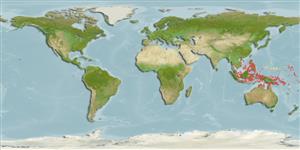Environment: milieu / climate zone / depth range / distribution range
Ecology
Marine; freshwater; brackish; demersal; amphidromous (Ref. 59012); depth range 0 - 5 m (Ref. 86942). Tropical; 22°C - 28°C (Ref. 12468); 19°N - 15°S
Asia and Oceania: Sri Lanka, Indonesia, Philippines, New Guinea, Admiralty Islands, Micronesia (Pohnpei, Caroline Islands) and Australia. Reported from New Caledonia (Ref. 13246).
Size / Weight / Age
Maturity: Lm ? range ? - ? cm
Max length : 34.0 cm SL male/unsexed; (Ref. 44894); common length : 15.0 cm SL male/unsexed; (Ref. 44894)
Found in freshwater, estuaries, inshore and mangrove (Ref. 86252). Adults occur on soft mud bottoms of rainforest creeks to elevations of at least 150 m. (Ref. 2847, 44894). They favor undercut banks for retreat. Probably has a pelagic marine larval stage (Ref. 44894).
Life cycle and mating behavior
Maturity | Reproduction | Spawning | Eggs | Fecundity | Larvae
Allen, G.R., 1991. Field guide to the freshwater fishes of New Guinea. Publication, no. 9. 268 p. Christensen Research Institute, Madang, Papua New Guinea. (Ref. 2847)
IUCN Red List Status (Ref. 130435: Version 2024-1)
Threat to humans
Harmless
Human uses
Tools
Special reports
Download XML
Internet sources
Estimates based on models
Preferred temperature (Ref.
123201): 27.4 - 29.4, mean 28.8 °C (based on 981 cells).
Phylogenetic diversity index (Ref.
82804): PD
50 = 1.0000 [Uniqueness, from 0.5 = low to 2.0 = high].
Bayesian length-weight: a=0.01000 (0.00420 - 0.02379), b=3.08 (2.88 - 3.28), in cm total length, based on LWR estimates for this (Sub)family-body shape (Ref.
93245).
Trophic level (Ref.
69278): 3.5 ±0.6 se; based on size and trophs of closest relatives
Resilience (Ref.
120179): Low, minimum population doubling time 4.5 - 14 years (Preliminary K or Fecundity.).
Fishing Vulnerability (Ref.
59153): Low to moderate vulnerability (31 of 100).
